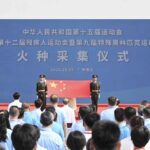During the National Day and Mid-Autumn Festival holiday, Chongqing continued to be exceptionally popular. This mountain-and-water city welcomed visitors from all directions with enthusiasm and sincerity, embedding warmth in the details to ensure both residents and tourists enjoyed a comfortable and delightful experience.
Enhanced Visitor Care Shows City’s Warmth
During the holiday, the long queues disappeared at the entrance of Chongqing’s Yangtze River Cableway scenic area, with all waiting barriers removed and replaced by rows of comfortable leisure chairs. More surprisingly, the cableway’s north and south station office areas were transformed into photo spots.
The second floor offers various local mountain city delicacies, while the third floor features cultural and creative souvenirs, including refrigerator magnets of Chongqing landmarks like the Yangtze River Cableway and Hongya Cave, as well as postcards. “I particularly love the miniature version of the Yangtze River Cableway, and I also bought refrigerator magnets, which are perfect as souvenirs,” said a tourist from Zhejiang.
The most popular is the free photo spot on the fourth floor, where cartoon-style cableway and mountain city elements create a unique picture frame. When the cable car slowly passes by, a simple snap turns into a stunning photo.
During the holiday, roads and bridges were closed for tourists, government canteens opened to the public, government compounds offered free parking, multiple museums including Chongqing China Three Gorges Museum and Hongyan Revolutionary History Museum eliminated reservation requirements, and there were drone shows for eight consecutive nights. “Chongqing is really treating its visitors so well!” Chongqing’s creative ways of caring for visitors have become an invitation from the city, allowing travelers from afar not only to encounter the city’s vibrant life and scenery but also to feel its gentleness and thoughtfulness.
One Bus Route Connects Popular Photo Spots
During this holiday, Bus Route 503 unexpectedly became a “popular sightseeing special line.” This long-standing bus route crossing two rivers and four banks connects over ten popular spots including Ciqikou, Liziba Light Rail passing through buildings, and Chaotianmen with an affordable fare of 2 yuan, praised by many tourists as “Chongqing’s most cost-effective way to sightsee.”
A tourist from Xi’an shared, “I discovered this bus route while planning my trip—it’s such a treasure!” He mentioned that his 3-year-old daughter asked many questions at each attraction, adding, “Every stop brings new discoveries.”
Since its launch in 2002, Route 503 has become a link between Chongqing’s cultural and natural landscapes. During the day, the clear waters of the Jialing River and the lush greenery of Nanshan Mountain unfold like a painting through the large windows; at night, the bus transforms into a mobile viewing platform, offering panoramic views of Hongya Cave’s sparkling lights and the Yangtze River Cableway’s radiant glow. The entire route takes about 90 minutes, and during holidays, it carries over 6,000 passengers daily on average.
A Service That Makes Travel Easier for Tourists
On the morning of October 7th, at Xiaoshizi Metro Station in Yuzhong District, a tourist from Chengdu stored her luggage in a Hive Box locker before heading empty-handed to the next photo spot. “Our luggage can be delivered to our home in Chengdu as early as this afternoon—so convenient,” she said happily.
During this National Day holiday, Yuzhong District launched a “local storage + cross-city delivery” service, setting up 154 delivery lockers at five major metro stations including Xiaoshizi, Shiyou Road, and Jiaochangkou. This service offers luggage storage and delivery from Chongqing to cities like Chengdu, Xi’an, and Guiyang, allowing tourists to travel hands-free and enjoy their trip with ease. Currently, cross-regional delivery is being piloted between Chongqing and Chengdu, with the fastest delivery from Chongqing to Chengdu taking just 6 hours.
“By utilizing lockers in urban metro stations and combining public transport with rail services, we provide a ‘metro + high-speed rail + storage’ delivery model aimed at helping tourists overcome the inconvenience of carrying luggage during their trips, making their travels more convenient and comfortable.”


